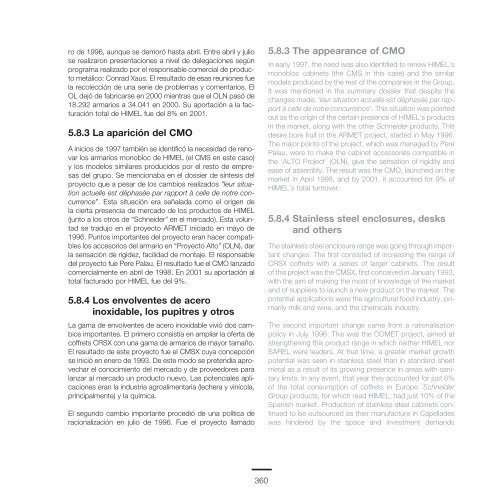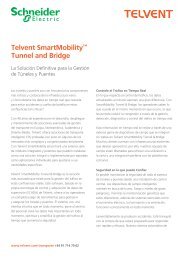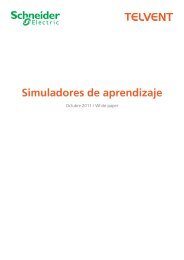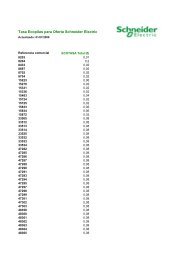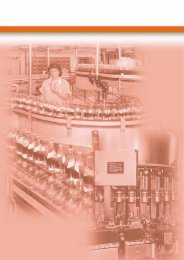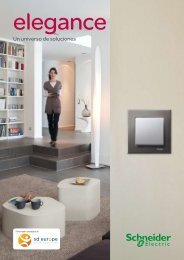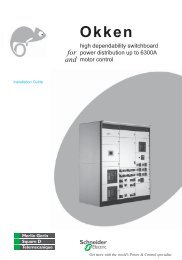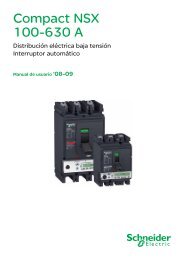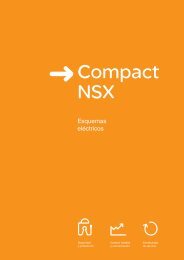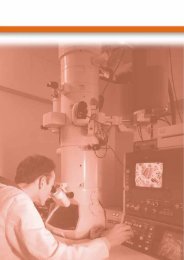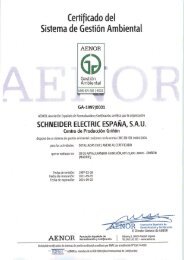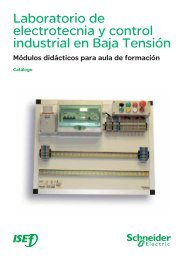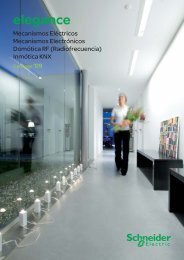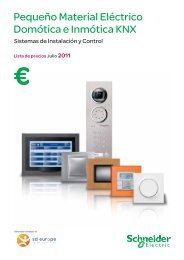Untitled - Schneider Electric
Untitled - Schneider Electric
Untitled - Schneider Electric
You also want an ePaper? Increase the reach of your titles
YUMPU automatically turns print PDFs into web optimized ePapers that Google loves.
o de 1996, aunque se demoró hasta abril. Entre abril y juliose realizaron presentaciones a nivel de delegaciones segúnprograma realizado por el responsable comercial de productometálico: Conrad Xaus. El resultado de esas reuniones fuela recolección de una serie de problemas y comentarios. ElOL dejó de fabricarse en 2000 mientras que el OLN pasó de18.292 armarios a 34.041 en 2000. Su aportación a la facturacióntotal de HIMEL fue del 8% en 2001.5.8.3 La aparición del CMOA inicios de 1997 también se identificó la necesidad de renovarlos armarios monobloc de HIMEL (el CMS en este caso)y los modelos similares producidos por el resto de empresasdel grupo. Se mencionaba en el dossier de síntesis delproyecto que a pesar de los cambios realizados “leur situationactuelle est déphasée par rapport à celle de notre concurrence”.Esta situación era señalada como el origen dela cierta presencia de mercado de los productos de HIMEL(junto a los otros de “<strong>Schneider</strong>” en el mercado). Esta voluntadse tradujo en el proyecto ARMET iniciado en mayo de1996. Puntos importantes del proyecto eran hacer compatibleslos accesorios del armario en “Proyecto Alto” (OLN), darla sensación de rigidez, facilidad de montaje. El responsabledel proyecto fue Pere Palau. El resultado fue el CMO lanzadocomercialmente en abril de 1998. En 2001 su aportación altotal facturado por HIMEL fue del 9%.5.8.4 Los envolventes de aceroinoxidable, los pupitres y otrosLa gama de envolventes de acero inoxidable vivió dos cambiosimportantes. El primero consistía en ampliar la oferta decoffrets CRSX con una gama de armarios de mayor tamaño.El resultado de este proyecto fue el CMSX cuya concepciónse inició en enero de 1993. De este modo se pretendía aprovecharel conocimiento del mercado y de proveedores paralanzar al mercado un producto nuevo. Las potenciales aplicacioneseran la industria agroalimentaria (lechera y vinícola,principalmente) y la química.El segundo cambio importante procedió de una política deracionalización en julio de 1996. Fue el proyecto llamado5.8.3 The appearance of CMOIn early 1997, the need was also identified to renew HIMEL’smonobloc cabinets (the CMS in this case) and the similarmodels produced by the rest of the companies in the Group.It was mentioned in the summary dossier that despite thechanges made, ‘leur situation actuelle est déphasée par rapportà celle de notre concurrence’. This situation was pointedout as the origin of the certain presence of HIMEL’s productsin the market, along with the other <strong>Schneider</strong> products. Thisdesire bore fruit in the ARMET project, started in May 1996.The major points of the project, which was managed by PerePalau, were to make the cabinet accessories compatible inthe ‘ALTO Project’ (OLN), give the sensation of rigidity andease of assembly. The result was the CMO, launched on themarket in April 1998, and by 2001, it accounted for 9% ofHIMEL’s total turnover.5.8.4 Stainless steel enclosures, desksand othersThe stainless steel enclosure range was going through importantchanges. The first consisted of increasing the range ofCRSX coffrets with a series of larger cabinets. The resultof this project was the CMSX, first conceived in January 1993,with the aim of making the most of knowledge of the marketand of suppliers to launch a new product on the market. Thepotential applications were the agricultural food industry, primarilymilk and wine, and the chemicals industry.The second important change came from a rationalisationpolicy in July 1996. This was the COMET project, aimed atstrengthening this product range in which neither HIMEL norSAREL were leaders. At that time, a greater market growthpotential was seen in stainless steel than in standard sheetmetal as a result of its growing presence in areas with sanitarylimits. In any event, that year they accounted for just 6%of the total consumption of coffrets in Europe. <strong>Schneider</strong>Group products, for which read HIMEL, had just 10% of theSpanish market. Production of stainless steel cabinets continuedto be outsourced as their manufacture in Capelladeswas hindered by the space and investment demands360


